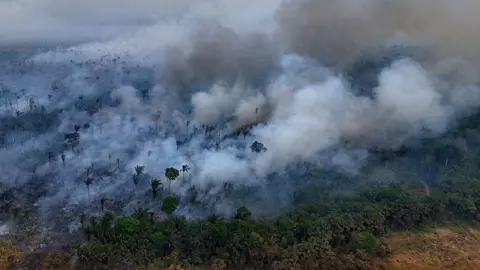Mark Poynting and Esme Stallard
BBC Climate & Science

 Getty Images
Getty Images
The world's tropical forests, which provide a crucial buffer against climate change, disappeared faster than ever recorded last year, new satellite analysis suggests.
Researchers estimate that 67,000 sq km (26,000 sq mi) of these pristine, old-growth forests were lost in 2024 – an area nearly as large as the Republic of Ireland, or 18 football pitches a minute.
Fires were the main cause, overtaking land clearances from agriculture for the first time on record, with the Amazon faring particularly badly amid record drought.
There was more positive news in South East Asia, however, with government policies helping to reduce forest loss.
Tropical rainforests store hundreds of billions of tonnes of carbon in soils and woody trunks. But this new global record raises further questions about their resilience on a warming planet.
Many researchers are concerned some forests, such as parts of the Amazon, may be approaching a "tipping point", beyond which they could fall into irreversible decline.
"The tipping point idea is, I think, increasingly the right one," said Prof Matthew Hansen, co-director of GLAD laboratory at the University of Maryland, which produces the data.
Prof Hansen described the new results as "frightening", and warned of the possible "savannisation" of the rainforest, where old-growth tropical forests die back and permanently switch to savanna.
"It's still a theory, but I think that that's more and more plausible looking at the data."
A separate study, published last week, made a similar warning of possible significant dieback of the Amazon if global warming exceeds the international target of 1.5C.
This would not only threaten the vibrant array of wildlife living in these most biodiverse habitats, but would also have serious ramifications for the global climate.
Until recently, the Amazon had been doing humanity a favour, absorbing more planet-warming carbon dioxide (CO2) than it released.
But the burning of these forests emits huge amounts of CO2 – adding to warming rather than limiting it.
In 2023-24, the Amazon experienced its worst drought on record, fuelled by climate change and the natural warming El Niño weather pattern.
Many fires are started deliberately to clear land for agriculture, making it difficult to disentangle the two.
But the drought provided ideal conditions for fires to spread out of control, with Brazil and Bolivia most badly affected.
While only a single year, it fits the expected pattern of more intense tropical fires in a warming world.
"I think we are in a new phase, where it's not just the clearing for agriculture that's the main driver," said Rod Taylor of the World Resources Institute (WRI), which is also behind the latest report.
"Now we have this new amplifying effect, which is a real climate change feedback loop, where fires are just much more intense and much more ferocious than they've ever been."
In total, the record loss of the world's old-growth (primary) tropical forests released 3.1 billion tonnes of planet-warming gases, the researchers estimate.
That's roughly the same as the emissions of the European Union.
Signs of progress
Countries in South East Asia, however, bucked the global trend.
The area of primary forest loss in Indonesia fell by 11% compared to 2023, for example, despite drought conditions.
This was the result of a concerted effort by governments and communities working together to enforce "no burning" laws, according to Elizabeth Goldman, co-director of the Global Forest Watch project at WRI.
"Indonesia serves as a bright spot in the 2024 data," she said.
"Political will is a key factor of success - it's impossible otherwise," agreed Gabriel Labbate, head of climate change mitigation at the United Nations forests programme UNREDD, which was not involved in today's report.
Other countries, including Brazil, have seen success in the past with similar approaches, but started to see losses increase again in 2014 following a change in government policies.
Prof Hansen said that although the progress in South East Asia was positive, the fluctuations in forest loss in Brazil show that protection policies have to be consistent.
"The key we haven't seen yet is sustained success in reducing and maintaining low levels of conversion of these ecosystems and if you were interested in conserving the environment you have to win always and forever," he told BBC News.
The researchers agree that this year's UN climate summit COP30 - which is being hosted in the Amazon - will be critical for sharing and promoting forest protection schemes.
One proposal is to reward countries which maintain tropical forests through payments. The detail is still to be worked out but has promise, according to Rod Taylor.
"I think it's an example of an innovation that addresses one of the fundamental issues that at the moment there's more money to be made by chopping forests down than keeping them standing," he said.
Graphics by Erwan Rivault











 English (US) ·
English (US) ·